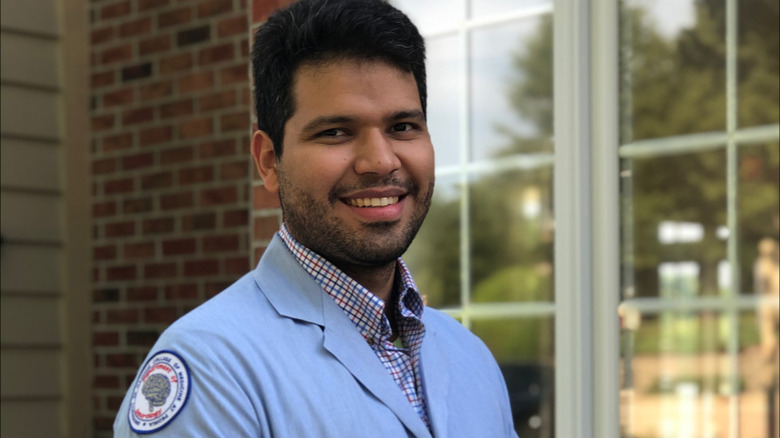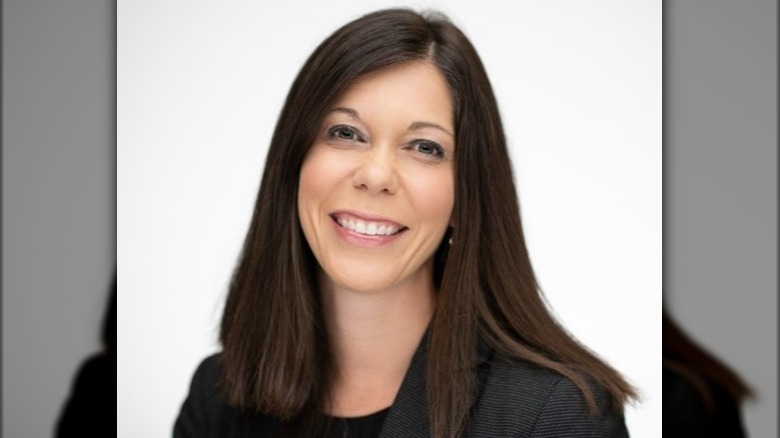The I'M IN Neurodisparity Fellowship Initiative Aims To Bridge Gaps BIPOC Patients Face - Exclusive Interview
Nearly 1 million people — that's the number of Americans living with Multiple Sclerosis (MS), a neurological condition that has the potential to be disabling. According to Johns Hopkins Medicine, MS is a chronic condition that affects the central nervous system, which consists of the brain and spinal cord. In MS patients, the immune system starts attacking the myelin sheath, a protective outer layer that covers nerves, and as a result, causes issues with various functions of the body that are dependent on communication with the brain, such as sense of touch, coordination, bladder control, and bowel motility (per Mayo Clinic). Eventually, this condition can lead to permanent nerve damage.
MS symptoms are felt differently in every person, with some experiencing more severe symptomatology. Common symptoms include, but aren't limited to, numbness or weakness in limbs, "electric shock" sensations, unsteady balance, and slurred speech.
For patients of color living with MS, getting access to neurological health care to help manage the condition can be difficult. A report by the American Academy of Neurology Diversity Leadership Group found that patients of color with MS often face worse outcomes than their white counterparts. Research conducted at the University of Miami found that Hispanic/Latinx MS patients (mainly of Caribbean descent) tended to be "younger at the time of diagnosis and had more mobility impairment than non-Hispanic white people with MS."
Dr. Luis Manrique-Trujillo, a neurologist at Medstar Georgetown University Hospital, hopes to address the health disparities Hispanic/Latinx MS patients face through the "I'M IN” EMD Serono Neurodisparity Fellowship Initiative. Medstar Georgetown selected Dr. Manrique-Turjillo to receive the funding from EMD Serono to study the Hispanic/Latinx population living with MS in Washington D.C.
Dr. Manrique-Trujillo and Dr. Lori Lebson, Head of Medical Affairs for U.S. Neurology and Immunology at EMD Serono, spoke exclusively to Health Digest about the significance of the fellowship and how they hope to address the barriers Hispanic/Latinx MS patients face.
Hispanic/Latinx patients in Washington D.C. face barriers in getting access to neurological healthcare
What are some of the barriers that Hispanic/Latinx patients face in Washington D.C. that can prevent them from getting access to neurological care?
Dr. Luis Manrique-Trujillo: That's an important question. We are in the process of identifying those barriers now with the help of funding from EMD Serono's "I'M IN" Neurodisparity Fellowship.
Washington D.C. has one of the largest Hispanic populations in the U.S. According to 2020 U.S. census data, 16% of patients in the D.C. area identify as Hispanic/Latinx, yet we see surprisingly few diagnoses of multiple sclerosis (MS) among the Hispanic population. If there are many more MS cases here than are being reported, this means many Hispanic individuals in D.C. may be living with a serious neurological condition that could be better treated and managed, but instead they are unnecessarily suffering additional difficulties because their cases are essentially occurring in the dark.
With regard to diagnosing MS, there is clear data about the different rate of incidents in different populations. Typically, the data indicates there are about 10 incidents per 100,000 Black individuals per year, but only 2.9 incidents per 100,000 Hispanic individuals. While this could mean Hispanic populations are three times less likely to develop MS, we believe this number is so low because Hispanic individuals are actually less likely to seek out a diagnosis.
The Greater DC-Maryland Chapter of the National MS Society provides services to approximately 15,000 patients living with MS in the D.C. area. However, the Georgetown MS and Neuroimmunology Center, which is one of the largest MS Centers in the area, has served approximately 5,100 of those patients with only 2.5 % identified as Hispanic/Latinx in our database collected during the last 2 years. As a result, we are trying to discern whether it's true that only 2.5% of MS patients in the D.C. area are Hispanic or whether they are largely going undiagnosed.
As for the obstacles to care for Hispanic patients, we believe this includes language barriers, immigration status, lack of access to insurance, financial challenges, and complex socio-cultural beliefs. For example, our clinic is located in Georgetown, and we sometimes hear that Hispanic patients feel uncomfortable visiting this neighborhood due to financial or geographic limitations.
Finally, there are also procedural disparities about how we ask for ethnicity data. The intake forms themselves can be an issue due to language challenges and concerns about data gathering. All of this can create a situation where diagnoses among different demographics are seriously underestimated.
However, we recognize that we may not be fully aware of all the barriers our Hispanic patients are facing. That is why we are actively canvassing and also planning to reach out to patients who are uninsured about the process of seeking medical attention. We want to know what they think the complications and consequences of seeking medical attention are. With more insight, we can work to mitigate any lack of knowledge and health illiteracy among our Hispanic population, better educate them on when to seek diagnosis, and help them overcome any socio-cultural beliefs that may be preventing them from seeking the care they need.
Data shows BIPOC neurology patients often face worse health outcomes
According to a 2017 report by the American Academy of Neurology (AAN) Diversity Leadership Group, data shows people from racial/ethnic minority groups as "frequently having lower rates of evaluation, diagnosis, and intervention," which leads to "worse neurologic outcomes" than white patients. What factors do you think are causing this to happen?
Dr. Manrique-Trujillo: When it comes to diagnosing and treating a neurological condition, the sooner you begin, the better your chances are of avoiding relapses or worsening conditions that will ultimately lead to worse outcomes.
The problem is that, sociologically, certain cultures do not like to talk about their personal health with doctors or clinical professionals. Instead, they may Google their symptoms or seek attention from alternative or spiritual therapies, which can lead to them becoming scared by the results and retreating from further care, diagnosis, and treatment.
For example, Black females tend to seek a diagnosis much more appropriately at the onset of a condition than Black males. Some people will only come in to seek a clinical diagnosis at the encouragement of their families. But by then, their condition may have progressed to a much more serious stage, which makes it harder to treat effectively.
It is worth noting that many barriers to care are also involved here, such as access to transportation, availability of childcare, and restrictions about taking time off from work in order to obtain healthcare. There is progress being made to reduce these disparities, but there is still so much more to be done in order to be able to provide equitable care and equitable access to that care. We are actively working to identify actionable steps that we can take to close that access gap.
The 'I'M IN' Neurodisparity Fellowship Initiative seeks to address health disparities affecting BIPOC neurology patients
What is the objective behind the "I'M IN" Neurodisparity Fellowship Initiative? What goals do you hope to achieve through the initiative?
Dr. Lori Lebson: In 2017, the American Academy of Neurology (AAN) Diversity Leadership Group published a groundbreaking report with recommendations aimed at reducing disparities in neurological care, also referred to as neurodisparity. This report found that advances in neurological care have not benefited all patients equally, with barriers to care often developing along racial, ethnic, and gender lines, as well as discrepancies among communities such as LGBTQ+, prison inmates, and religious minorities.
As a result, AAN and other healthcare practitioners across the neurological field are becoming more aware of biases and other barriers that are inherent in every aspect of care from intake and evaluation to intervention and rehabilitation. By working to eliminate these biases, increasing health literacy, and promoting neurodisparity research and communication, the goal is to provide more sustainably equitable neurological care for all patients across all demographics. To accomplish this, research like ours is being conducted in a way that will ideally lead to mitigation strategies that can be replicated at other institutions throughout the country. It is crucial that we not just identify the problems, but also the strategies and tactics for resolving them.
Through initiatives like the "I'M IN" Neurodisparity Fellowship, EMD Serono wants to help improve healthcare for generations to come. This is the start, not the finish line.
Connecting with MS patients is key in helping them navigate their journey
The fellowship will be focusing on Multiple Sclerosis (MS) patients. What does it feel like to have MS?
Dr. Manrique-Trujillo: MS is a chronic condition with symptoms that manifest differently in every patient, but the effects of the disease inevitably become a very prominent part of each patient's identity. As an MS patient, you may feel as if your brain is on fire, or experience recurring numbness, dizziness, vision issues, and other debilitating symptoms that may come and go but which typically progress and become less stable over time. This can lead to a large amount of anxiety and uncertainty about what is happening within your body.
The fact that most MS symptoms are invisible to outsiders makes this frustration even more difficult, because the people around you don't fully recognize or understand what you're really experiencing. Relief is possible when you are working with someone who understands what is going on with you and can prescribe treatments that can help mitigate the symptoms, but getting to that point is often a long journey for MS patients who are still navigating their own awareness of and reactions to their condition.
Why did you decide to focus on Hispanic/Latinx patients living with MS?
Dr. Manrique-Trujillo: As an immigrant who is Latinx, I have a personal connection with my community. My Hispanic patients come to me because I look and sound like them, which helps them feel a greater level of comfort during care. It's important to me that I am able to help my patients in their moments of distress.
From a macro perspective, it's also very important for us as a medical community to figure out why we have such a steep discrepancy in MS diagnosis data in Hispanic populations. Are they really experiencing fewer incidents? Is there an unidentified protective factor? Or is it that we are unintentionally creating persistent obstacles to receiving accurate diagnoses and efficient care through barriers that we can remove once they are identified?
Learn more about EMD Serono and the "I'M IN" Neurodisparity Fellowship Initiative on the EMD Serono website.
This interview was edited for clarity.





